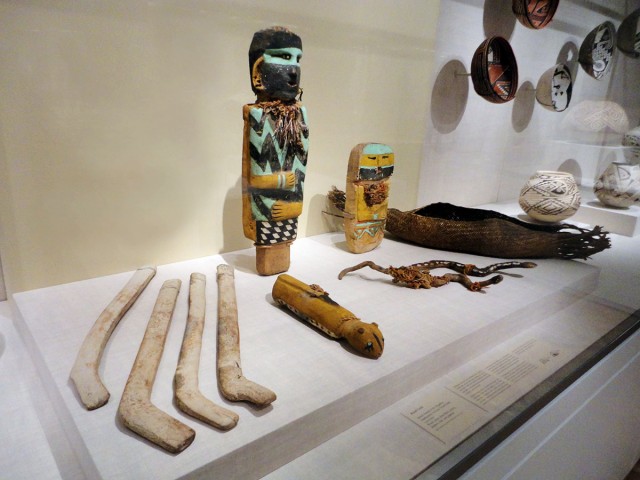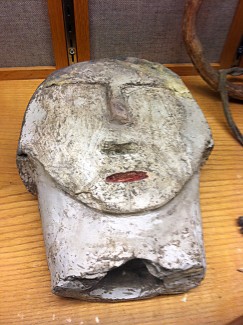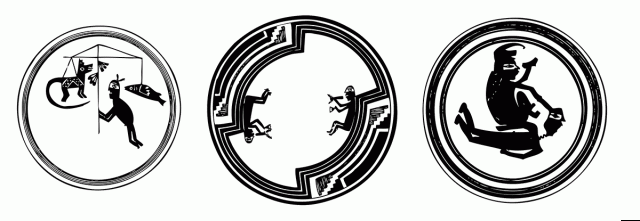- Home
- >
- Preservation Archaeology Blog
- >
- Faces of Salado?
In 1972, a cache of truly remarkable items—a large, wooden human figure and a slightly smaller stone human figure accompanied by animal effigies, textiles, and wooden objects—was recovered from a cave in the Cliff Valley, along the Upper Gila River in New Mexico. The objects are described in a 1978 University of New Mexico master’s thesis by Henry Walt (and most of the information in this post comes from Walt). I knew of the cache, but I didn’t know that it had been purchased by the Art Institute of Chicago (AIC)—so I was very surprised to stumble across it in a gallery at the AIC on a weekend visit last month. Seeing the objects in person prompted me to go back to the report and to think about how these objects fit in with our work in the Upper Gila.

For the sake of brevity, I’ll focus on the human-shaped (or anthropomorphic) figures. Both anthropomorphs have drilled holes in the tops of their heads and in their ears that presumably would have held additional objects or pieces of adornment not stored with the cache. Although the AIC website describes the wooden and stone figures as male and female, respectively, neither figure has visible biological sex characteristics.

The face of the 14-inch-tall stone figure, with its rectangular nose and small oval mouth, bears some resemblance to another remarkable Cliff Valley find—a stone head that Jack and Vera Mills found in the late 1960s during their excavations at the Dinwiddie site (also the location of our most recent season of field work). The Dinwiddie head, which is now on display at Eastern Arizona College, measures 10 inches in height and seems to have been meant to be mounted on some kind of frame. It’s more three-dimensional than the Cliff Valley cache figure, with black paint, presumably representing hair, on the back and sides of the head. Somewhat confusingly, the Dinwiddie head also appears to have two mouths. To the best of my knowledge, the interpretation of the stone Cliff Valley cache figure as female is based entirely on the association of the color yellow with femininity in some historic pueblos.
I know of no obvious sculptural comparison for the remarkable wooden figure, but the shape of the nose, mouth, and eyes, along with the colored band across the eyes, are extremely similar to the features of figures which appear on some Mimbres Black-on-white bowls. Marit Muson has argued that the “eye mask” facial marking is associated primarily with male individuals in the designs on Mimbres bowls. The figure’s necklace includes feathers from several species, but perhaps the most interesting is the scarlet macaw. Macaws seem to have been important in the Classic Mimbres phase in the Mimbres Valley and macaw remains were found at the thirteenth-century Gila Cliff Dwellings. To my knowledge, macaw remains haven’t been recovered from other sites in the Upper Gila, although it is also true that very little faunal analysis has been done.

Walt submitted samples from the wooden figure and from one of the textiles accompanying the figures for radiocarbon dating. The dates suggest that the cache was produced, used, and retired sometime between the early 1200s and the late 1400s. This supports an association with the Salado or Cliff phase occupation of the valley (or possibly with the very thin thirteenth-century Black Mountain occupation). Concerns have been raised about the accuracy of the radiocarbon lab which produced Walt’s result, however.
So, the question remains: does the cache represent a rare window into Salado religion? If so, then the presence of the very Mimbres-like figure is particularly interesting. Or, were the figures and other material placed in the cache by the earlier inhabitants of the Cliff Valley?
Note on the radiocarbon dating: Walt submitted his samples to the now defunct Dicarb Radioisotope Company in the late ’70s. He reports two results for the wooden figure, A.D. 1260 ±95 and A.D. 1270 ± 125, and one for the cotton textile, A.D. 1470 ± 70. Although Walt does not explicitly state this, I assume these are uncalibrated dates and 2 sigma ranges. A quick and simple calibration with the online CalPal tool yields calibrated 2 sigma date ranges of A.D. 1301 ±73, 1292 ± 92, and 1429 ± 70. A systematic study of Dicarb’s dates of Alaskan archaeological samples in comparison with those from other laboratories found a tendency for Dicarb’s dates to be significantly younger. It’s possible that this has no bearing on the cache dates, but redating the cache would be desirable. If anyone has any information on Dicarb or additional dating that may have been done on the Chicago cache, I’d love to know.
Data sources include: the Mills’ report on Dinwiddie, The Artifact, Vol. 10, no. 2. 1972; Marit Muson’s chapter in Mimbres Society, ed. Powell-Martin and Gilman, University of Arizona Press, 2006; Henry Jerome Walt, “An Effigy Cache from the Cliff Valley, New Mexico,” Master of Arts Thesis, University of New Mexico. The examination of Dicarb’s dates by Reuther and colleagues was published in Radiocarbon Vol. 47, no. 3, 2005, available here.
11 thoughts on “Faces of Salado?”
Comments are closed.

Great article, the sticks look like rabbit sticks, kind of like Australian aboriginal boomerangs or miniature O’odham “toka” sticks.
Hi Katherine:
Nice article!!! You were lucky to find these items and get to study them!!
What is the date of Walt’s thesis??
Does Archaeology Southwest intend to redate the items??
Cheers, Jim
The “lost” are found, & great to have photos of them for continued study. In regard to the Dinwiddie head, compare the stone human effigies in Vol. 7 of the Casas Grandes report. I’ve loaned/lost my copy of our Gila Cliff Dwelling report, but it had a list of macaws found in the area. And Amerind has a kachina-like painted slab from Point of Pines, I believe.
Glo
Thanks for the comments, everyone! Gloria, I’ll certainly check out your sources — I had no idea there were stone effigies from Casas Grandes! Jim, apologies for leaving the date out of the references. Walt’s thesis is from 1978. I’d love to see the material redated, and a larger dating program for the other incredible cave assemblages in the Upper Gila and eastern Mogollon Highlands, but we haven’t got that in the budget right now. AMS dates are, alas, not inexpensive. Marc, yes, that’s Walt’s interpretation as well. He didn’t think they’d ever actually been used, though, since they apparently didn’t have much in the way of use wear. As you note, there are lots of interesting aspects to the cache beyond the anthropomorphs!
The big fellow was on a USPS stamp back in 1989. Various sources(including AIC website!) state that the cache was found in SE AZ. A canard: I’m fairly certain it was found along the Gila in or above the Cliff Valley. In 1972, the fellow who found it showed us photos (but not the objects!) and described the general location of the cave. More than likely from Gila NF lands, but who knows? The possible Federal provenance may explain the mis-attribution to SE AZ…
Thanks, Steve! I had no idea about the stamp. My best guess about AIC’s provenience statement, based on the phrasing on the website, is that they were told that it was affiliated with the “Salado Culture,” which they then later associated with southern Arizona based on a literature search. It would be fun to look at any information in their accession file, though.
Katherine – thanks for posting the new info on these items. I’ve been curious about them since seeing a picture in Townsend’s AIC publication on Casas Grandes ceramics. Two quick comments. In some cases the old Dicarb dates (and those of other defunct labs like Radiocarbon Limited)were presented in reports as calibrated calendar intercept dates using the old Klein et al. curve. To update these dates, you have to “uncalibrate” the reported calendar date and then recalibrate the BP age using the modern curves. Realistically, it may not make much of a difference because this segment of the calibration curve doesn’t affect the dates that much and also because the error estimates of the original dates are so broad. I’m not sure if the dates reported by Walt were calibrated, but it is worth keeping in mind. Second, you mentioned other items in the Mogollon caves – we’ve recently dated 15 tablitas and painted wood items from the Cosgrove collection from Doolittle, Steamboat, and Mule Creek caves as well as several caves in the Jornada region. So there is a start in that direction.
J. Louis Argend-Farlow studied this cache in the 1980s. He was working on a rock art thesis in Art History at Texas at the time. I have lost track of him. I can’t recall if he wrote an MA thesis on this, or just gave some conference papers. He argued that the figures represent the Hero Twins, specifically the Zuni twins. The rabbit sticks fit with that interpretation (the Hero Twins played with rabbit sticks in many oral traditions). If anyone knows where Lou is let me know!
Myles – Thanks for the comments! I’d love to see your dates from the Cosgrove collections, if you’re willing to share or could point me toward a publication to read. Kelley — I didn’t know that that additional research was out there. Thanks! Based on some quick googling, it looks like he did a thesis at the University of Texas, Austin. I’ll have to see if I can find a copy. I know Pat Gilman and her colleagues have been looking at Mimbres designs in terms of Hero Twin mythology, and it’d be fun to compare their interpretations.
re:Gloria’s Oct 31 note…I can’t find a macaw list in the Gila Cliff Dwelling material but it is shown in Charmion McKusick’s “Southwest Birds of Sacrifice” (both authors names appear on “The Archeology of Gila Cliff Dwellings”…)
Thanks, Jim! Since this post, I’ve had a couple of additional Upper Gila macaws pointed out to me. There’s a scarlet macaw burial, probably dating to the Mimbres Classic period, at Wind Mountain. Macaw remains were also recovered from a site called Freeman Ranch, which is probably the same Upper Gila Salado site better known as the Hilltop Site (thanks to Darrell Creel for the latter information!)